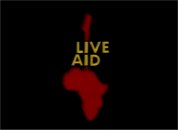
TV Pop Diaries
Pop Music on British Television 1955 -
After the unexpected phenomenon of the Band Aid single, Do They Know It's Christmas,
a follow-
The TV presentation would not be given to Channel 4's The Tube, whose show was instrumental in helping to create the Band Aid single in the first place and whose cameras captured the recording process on that November Sunday morning. Band Aid instead chose the BBC who in turn brought in the production team from The Tube's avowed nemesis, Whistle Test.
Despite (a word that will appear a lot in this article) the concert's importance,
and a potentially world-
Trailers promoting the forthcoming show ran on the BBC from the beginning of July,
suggesting that Culture Club, Huey Lewis & The News, Billy Ocean, Stevie Wonder,
Judas Priest, Billy Joel and Tears For Fears would be appearing. Despite the tease
of the promos none of these names would actually appear. Thankfully the Trades Descriptions
Act probably couldn't be applied to a final line-
Despite the seeming lack of commitment from American acts (no Prince, Michael Jackson,
Stevie Wonder, Paul Simon, Diana Ross among others) the American audience was seen
as the primary target as far as money raising was concerned, after all it was a money
raising event only. When the show kicked off at mid-
Despite the temptation, very little product placement was evident with small logos for Pespi, AT&T and Kodak atop of the Wembley stage. Money was the only point, the only purpose of the show in the first place, but despite the stellar attractions money was slow in coming in, that was until about 7.40 pm when David Bowie introduced a clip assembled by a news team at CBC in Canada. Momentarily everything just stopped, and then the phone lines lit up.
Despite (that word again) the criticism at the time, and later parroted by critics that no British black acts were present (the names Aswad and Steel Pulse were usually brought up) the two biggest contemporary British black acts were approached, with Sade appearing, but the other, Billy Ocean, backing out.
The American half of the show would be produced by rock promoter and ex-
Yusef Islam/Cat Stevens was on the sub's bench that day and is probably still baffled as to why he wasn't asked to go on. A tentative schedule shown on TV the night before the concert had him on stage at around 9.00 pm.
Sartorially the show will be remembered for the dazzling range of long coats on display on the UK side, with Midge Ure, Tony Hadley and others all going to the long coat wardrobe, probably for the last time. A fantastic selection of mullets were also on parade, with Bob Geldof, Bono and, backstage, Andy Kershaw all sporting fine examples, thankfully all recorded for posterity, which raised a further problem. The Band Aid Trust explicitly requested the BBC not to record the show, probably fearing video piracy, but since the show was being recorded on so many domestic video recorders anyway the BBC felt that the request was a pointless gesture, beside they had to record both video and audio for legal compliance reasons. Those recordings were eventually released as a twentieth anniversary DVD box set by Warner Music and then by EMI a few years' later.
LIVE AID FOR AFRICA
BBC2/BBC1
13/14th July 1985
